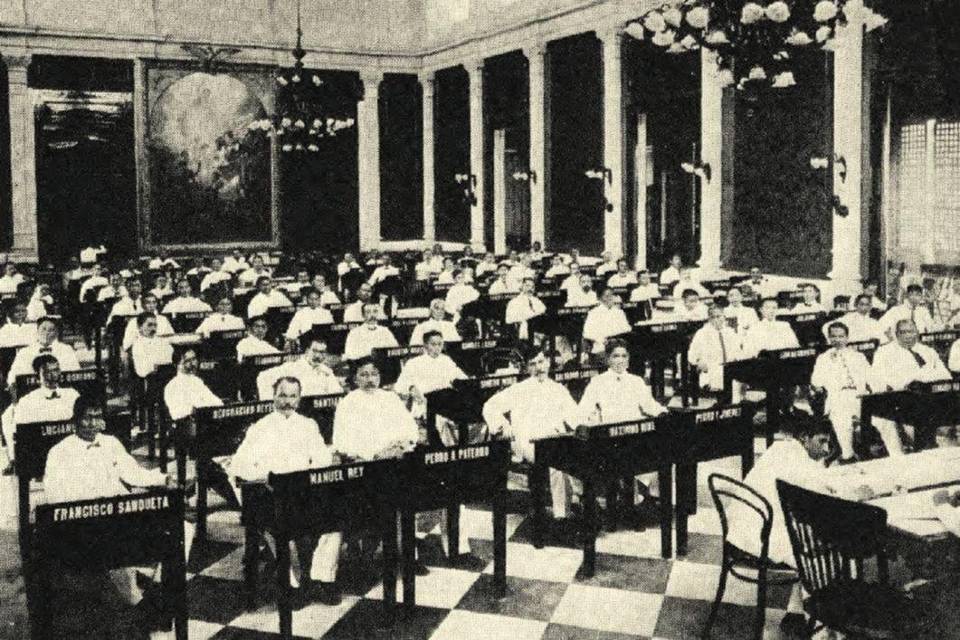 The Philippine Assembly, elected in 1907. (Photo courtesy of Clyde Tavenner)
The Philippine Assembly, elected in 1907. (Photo courtesy of Clyde Tavenner)
A Micro Mini View of Pinoy Election
We were discovered by Magellan on March 16, 1521 when he accidentally landed in Limasawa, Leyte. Before this date, we had no elections. The ruler of the Balangay tribe was the strongest in battle who had killed all his rivals.
From March 16, 1521 to December 1898 when Spain sold us to America for 20 million dollars (roughly one dollar per head because in 1898 our population was about 17 million.) we still had no elections. The leaders of the pueblo’s provincias, cuidades were appointed by the American governor general from 1898 to 1902. America’s Congress passed the 1902 law which allowed us to choose our leaders by way of elections, not appointments.
In 1902 except for China and Japan, all the Asian nations were colonies of the White Race. Britain had Egypt, Persia (now Iran), Afghanistan, Pakistan, India, Malay Peninsula, Singapore, Burma, Hong Kong, and 2/3 of Borneo. France had Laos, Cambodia, and Vietnam. Holland has Indonesia. U.S had tiny Goa, and Macao.
For the record, in 1902 U.S was the first colonizer to allow their subjects (meaning we, proud kaliwat ni Lapu-Lapu, Princessa Urduja, and Gabriela Silang) to vote for the local leaders in 1902. You can vote if you were (1) 21 years old and above, (2) read and write English and Spanish, (3) own land worth Php500/person or more or pay Php30 tax yearly. You cannot vote (1) if you are a woman, (2) do not own land, (3) do not pay taxes or if your yearly tax is below Php30.00, (4) do not read and write. The national law making body was called the Philippine Assembly.
The first political super stars were Cebu’s Sergio Osmeña, Sr. and Baler’s Manuel Quezon who were schoolmates in Letran and the UST law school. They were our top leaders from 1902 up to 1946 (Quezon died in USA in 1944). In 1916, U.S Congress passed the Jones law (after the sponsor, Virginia’s Congressman William Jones). The big change was in the national law making body; it had a Senate and a House of Representatives. This was the first time we had a bicameral legislature.
In 1934 the U.S Congress passed the Tydings-McDuffie Law named after the 2 lawmakers who sponsored it. It ordered a Constitutional convention so that we can have our own Constitution because in 1994, we will be given independence. World War 2 from 1941 to 1945 delayed our independence. On July 4, 1946, we became a nation. America made sure we will always remember it made us a nation because July 4 was their independence day. Pres. Macapagal changed our independence day because on June 12, 1898 President Aguinaldo declared our independence in Kawit Cavite.
The law passed by the Philippine congress for a constitutional convention also called for a plebiscite if women should be allowed to vote. Doña Aurora, wife of Pres. Quezon supported Mrs. Lim who became the National President of all women clubs created all over the nation to make sure that 300,000 women will vote yes. Thus in 1940, for the first time, women could finally vote.
The 1973 Constitution (approved by raising of hands in nationwide barangay meetings not by secret balloting) made 2 great changes (1) reduced the voting age from 21 to 18 years old. It was observed that males who are 17 years old in case of war they must join the military. If he is old enough to die for his nation, he is old enough to vote. (2) Illiterates can vote. This helped the 20% of the 100 million Filipinos belonging to indigenous tribes, most of whom are illiterate, to have a say in the fate of their lives. From 1898 to 1946, the no. 1 national office was the American Governor General. The speaker of the 1902 national assembly was a Filipino but the national chief executive was the American Governor General. In 1916 Jones law saw the rise of the most brilliant charismatic leaders: Sergio Osmeña, Sr. (Cebu) and Manuel L. Quezon (Baler). The 2 dominated our political system from 1902 to 1946. Osmeña lost the first presidential election of the third Republic in 1946 to Liberal Party Candidate Manual A. Roxas of Capiz.


No Comments